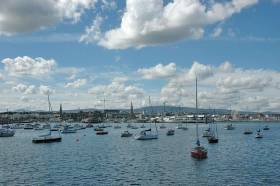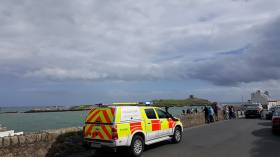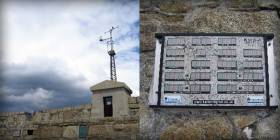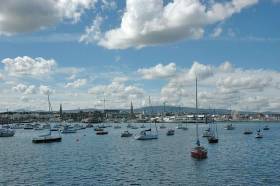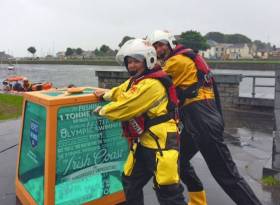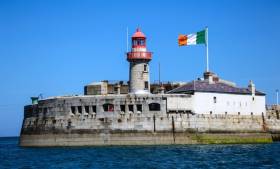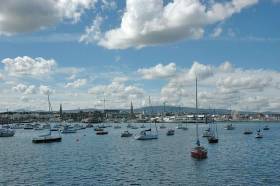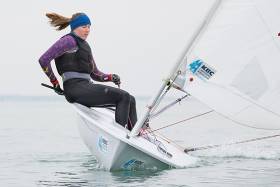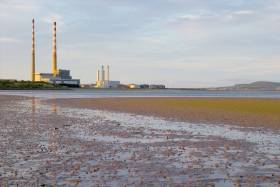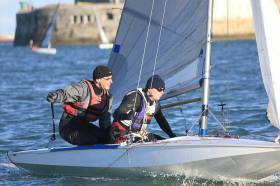Displaying items by tag: Dun Laoghaire
Dun Laoghaire Harbour Chief Lodges High Court Action Against Company
#DunLaoghaire - Dun Laoghaire Harbour Company chief executive Gerry Dunne has lodged High Court proceedings against his employer, according to Sunday Business Post business correspondent Jack Horgan-Jones in yesterday’s edition of the paper.
Dunne, who was appointed CEO in 2009, spearheaded the ‘masterplan’ for regeneration of the south Dublin harbour that has in recent years lost its long-time passenger ferry link to Britain.
Under Dunne’s oversight, plans for the harbour have included a now-cancelled diaspora centre, an ‘urban beach’ project that received planning permission in mid 2015 but was not realised as expected this summer, and a new cruise terminal to accommodate next-generation liners that was at the centre of oral hearings last year.
More recently, the possibility of hosting a floating hotel or ‘flotel’ in the harbour has been mooted.
However, Horgan-Jones writes that these ambitious projects have been subject to “reservations at the highest level of government”, with one civil servant raising concerns about the soundness of the harbour’s corporate plan.
In response to our request for comment, Dunne said that the precise matter of the High Court action is currently sub judice.
RNLI Dun Laoghaire in Dalkey Island Call Out
It was a busy afternoon for Dun Laoghaire All-Weather RNLI lifeboat, Dun Laoghaire Coast Guard and Coastguard Helicopter Rescue 116 woh responded to a calls with good intent as southerly winds are gusting over 50 knots on Dublin Bay today. The rescue services responsded to reports that three people were stranded at the Muglins Rock lighthouse at the southern tip of Dublin Bay, off Dalkey.
New Location For Dun Laoghaire Harbour Weather Station
#Weather - The Dun Laoghaire Harbour Company advises of a new location for the harbour's weather station, which had been inactive since 6 June this year.
Live weather data can now again be found on www.dlhweather.com (times given in GMT).
Dun Laoghaire Harbour Transfer Going Ahead, Is Best Move For Its Future Says Minister
#DunLaoghaire - The Transport Minister maintains that transferring the operation of Dun Laoghaire Harbour to the local authority is the best move for its sustainable development.
Responding to a Dáil question earlier this month from Dun Laoghaire TD Seán Barrett, who asked for clarity on the future of the South Dublin port, Minister Shane Ross confirmed that it is still designated for transfer to Dun Laoghaire-Rathdown County Council.
However, the minister also acknowledged the "dispute about the ownership and future model" for the harbour, which stems from Dun Laoghaire Harbour Company's reaction to changing commercial and economic conditions, such as the withdrawal of the Stena Line ferry service, which saw profits sink in 2015.
"My department is aware that the ongoing challenge for the port will require sustained effort across a number of fronts," he said. "This may even involve the sale of some non-strategic assets."
Other potential projects include the recently tendered 'flotel' concept, which is now seeking expressions of interest.
The minister did not respond to Deputy Barrett's assertions that the local authority has neither the expertise nor management structure to run the port effectively.
More recently, Minister Ross answered a request for statement from Dun Laoghaire TD Richard Boyd Barrett, who again raised the issue of anomalies in executive payments by the harbour company, as well as concerns over alleged pension scheme irregularities ahead of a meeting between company trustees and the Pensions Board next week (Wednesday 27 July).
Noting that there was "obviously a misunderstanding or certainly a conflict of evidence" regarding legal acton to recover expenses paid to a former board member, the minister said that he could not comment on the matter and that his "powers in this particular matter are limited".
However, he welcomed the opportunity for meeting with any stakeholders Deputy Boyd Barrett might arrange.
#RespectTheWater - The RNLI has placed a tonne of water in Galway and Dun Laoghaire respectively for the summer months in a bid to show visitors and locals alike the power of the water, river and sea.
The tonnes of water, which will be located at the Spanish Arch in Galway and Dun Laoghaire's East Pier until the end of August, forms part of the RNLI’s Respect The Water campaign.
Each tonne is printed with important advice about the power of water, such as how fast a rip current can flow. They will also demonstrate to people how heavy a relatively small volume of water is – one cubic metre of water weighs one tonne.
They were created to be a visual and engaging way of delivering this message that no matter how strong a swimmer you might be, you are no match for the power of the water.
Last month the RNLI launched its annual national drowning prevention campaign, Respect The Water, and this year the charity is warning the public to watch out for key dangers that can catch people out in or near water.
Dun Laoghaire Harbour's 'Stolen' Tricolour Recovered
The giant Irish flag 'stolen' from its prominent position on Dun Laoghaire's East pier has been recovered.
The tricolour went missing last night from the flag pole at 7pm.
Afloat.ie sources tell us that it is now back with its rightful owners and the hope is that it will be flying from the pier head again soon.
#DunLaoghaire - The Dun Laoghaire Combined Clubs will hold a fundraising day next week to help cover costs associated with last year's oral hearing over the proposed harbour terminal for cruise liners.
Harbour Heritage Day on Thursday 16 June aims to "galvanise the sailors to show solidarity and not only to contribute but to underwrite the €48,000 needed to clear our debt", according to a letter to members from the National Yacht Club.
Boat owners are encourage to arrange collection from their crews, and voluntary donations can be made directly via bank transfer (contact the club for details via nyc.ie).
No decision has yet been made on the controversial Dun Laoghaire Harbour cruise berth proposals after An Bord Pleanála deferred its ruling in January, as previously reported on Afloat.ie.
The KBC Laser Radial Worlds (Youth and Men’s 2016 World Championships) was launched at a special event in Dún Laoghaire Harbour Company’s historic Harbour Lodge today. This is the first time Ireland will host this sailing World Championship which, according to Eithne Scott-Lennon, Chairperson, Dún Laoghaire Harbour Company “will showcase Dún Laoghaire Harbour on the international sailing stage”. Up to 400 competitors from more than 35 nations will compete in this World Championship Series which will generate €2.5m for the local economy.
KBC Bank Ireland is the title sponsor of this prestigious sailing event which takes place in Dún Laoghaire harbour from 23rd to 30th July and will be hosted by The Royal St. George Yacht Club and Dún Laoghaire Harbour Company. The event is supported by Dun Laoghaire Rathdown County Council and Fáilte Ireland.
Eithne Scott-Lennon, Chairperson, Dun Laoghaire Harbour Company said, “This summer Dún Laoghaire Harbour will be the first Irish host of the eagerly awaited KBC Laser Radial Youth & Men’s World Championships. The Harbour Company along with the Dún Laoghaire Yacht Clubs formed a small group in 2013 to promote the harbour as a location for International Sailing Events. We are delighted that the 2016 ‘KBC Laser Radial Worlds’ is a direct result of that initiative.”
Patt Watt, Director of Retail Distribution, KBC Bank Ireland said, “As Ireland’s newest retail bank we are delighted to sponsor this world-class sailing event. Our sponsorship acknowledges our commitment to supporting community and youth initiatives and recognises the hard work and dedication that is involved by everyone concerned in hosting this event. We wish everyone every success and look forward to being part of a great sporting occasion next July.”
David Kelly, Chairman of the KBC Laser Radial Worlds said, “This is a significant achievement and an exciting milestone in the sailing history of Dún Laoghaire. Apart from the financial benefits locally, it is a unique opportunity to showcase our beautiful harbour and everything Dún Laoghaire has to offer. We are looking forward to some top-class sailing and to welcoming all our competitors from all over the world.”
1,000 supporters and volunteers will be involved in helping to host the KBC Laser Radial Worlds. Over the past number of years Dún Laoghaire has played host to some of the most prestigious European & World Sailing Championships including the Youth Sailing World Championships in 2012.
Two walkers were rescued by the RNLI inshore lifeboat from Dun Laoghaire shortly after midday today when the rising tide surrounded them half a mile from shore off Sandymount.
The pair raised the alarm by mobile phone to the Irish Coast Guard Dublin rescue co-ordination centre (MRCC Dublin) giving details of their difficulty. They then attempted to walk towards shore but with the water-level waist deep and rising they returned to the sandbank to await rescue. Their phone became water-logged in the fast-rising tide and with two hours to high-water, the sea-level was rising faster than walking in water-logged clothing would allow.
MRCC Dublin contacted the RNLI Inshore lifeboat (ILB) from Dun Laoghaire that was on exercise with four volunteer crew on board and requested that they proceed immediately to the scene. The Irish Coast Guard helicopter at Dublin Airport was also tasked and both arrived on scene at 12.15pm
The ILB crew walked the remaining 50-metres with life-jackets for the two walkers who were then brought by lifeboat to Dun Laoghaire. Neither was harmed though First Aid for a minor injury was given to one of the walkers. The Dun Laoghaire Coast Guard Unit attended at the RNLI station and brought the casualties back to their car at Sandymount by road.
“Walking on our local beaches is very popular but care is needed in respect of the state of tide that is constantly changing,” commented Robert Fowler, Deputy Launching Authority with Dun Laoghaire RNLI. “From low-tide to high, water-level can become several metres deep in the course of a long-walk at the waters’ edge.”
A recent risk-analysis by the RNLI for the Dun Laoghaire station indicates that walking poses one of the most significant hazards in the area with today’s incident the third of its kind to date this year.
The ILB is one of two lifeboats stationed by the RNLI at Dun Laoghaire and is ideal for operating in shallow water and close to rocks. The volunteer crew typically launch within six minutes of being paged but were already at sea today on one of two weekly routine training exercises.
Ten Fireballs Race in the Sunshine At Dun Laoghaire
There was almost a full turnout of the Fireballs registered for the 2015/16 Frostbites in Dun Laoghaire yesterday when 10 boats assembled on the start line for the first of two trapezoid-course races in sunshine but cool temperatures writes Cormac Bradley. The forecasts for the afternoon were a bit mixed with one site suggesting the N-Westerly would go Northerly and fade while another suggested it would go Southerly and build a little. In the end it was the former forecast that won out.
Two early practice rounds of the course revealed conditions that required trapezing upwind and tight spinnaker legs across the top and bottom of the trapezoid but as the afternoon progressed, the need for trapezing faded though the reaches were still lively.
In Race 1 the fleet had various ideas on how to work the first beat, the Clancy brothers, Conor and James, making a first appearance after a few weeks absence, decided that hitting the East Pier was the way to go with a weather mark just inside the end of the West Pier. The rest of the fleet demurred to varying degrees, preferring to work the middle and left of the course. The majority view was vindicated at the first weather mark with a rounding order of Noel Butler & Stephen Oram (15061), Alistair Court & Gordon Syme (14706), Darragh McDonagh & Neil Duke (14434), Neil Colin & John (14775), Frank Miller & Cormac Bradley (14713). Team Clancy were down in 7th in close proximity to Cariosa Power & Marie Barry (14854), Louise McKenna & Tim (14691), Mary Chambers & Brenda McGuire (14865) and Peter & Michael Keegan (14676).
By the time the first half of the fleet got to Mark 2, Butler & Oram had pulled out a short lead. At the gybe, Miller gained two places by getting inside McDonagh and Colin and with a faster spinnaker set was able to pull away and to windward of them – time to hunt down Court!
On the second beat, Miller worked the right hand side of the course while Butler and Court worked the middle. By the time they reached the 2nd weather mark, Miller had closed dramatically on Court and they rounded with Miller only just ahead. Butler of course was doing his normal thing of putting distance between himself and the rest of the fleet. Halfway down the top leg of the trapezoid Miller was able to break the overlap with Court and put a few boat-lengths between the boats. This position was retained to the rounding of Mark 4. Behind them, Chambers had dropped out, Colin too had dropped out after an incident on the water and the chasing boats were now Power/Barry and the Clancy brothers.
Third beat and Butler and Court both go left immediately! As piggy in the middle, Miller goes right – a potentially dangerous ploy, leaving the opposition to do their own thing. As they entered the last stages of the beat Court crosses ahead but a few minutes later when they cross again, Miller has sneaked in front. Miller gets to the weather mark first and holds Court off to Mark 4. On the final beat, Miller is much more circumspect, only taking a short hitch to the right to see what Court will do on rounding 4. When Court tacks, so does Miller and the pair sail in close company up the left hand side of the course, with Miller to windward. Butler is “long gone” sailing his own comfortable race. Behind Court and Miller, both Clancy and Power close but not enough to give the “heebie-jeebies” just yet! Miller tacks first for the port lay-line and gets to the weather mark first ahead of Court who is in a slightly more windward slot.
The last lap is now a race between the Clancys and Power & Barry with the lighter ladies more than holding their own. They exchange the lead a few times on the top leg, but on the longer leg between 2 and 3 the ladies get into a more secure position and hold off the brothers to the finish.
The fading and northerly shifting breeze now necessitates a change of course but due to the logistics of the harbour, it is not enough to move the weather mark, the committee boat has to move as well, moving inshore towards the gantry for the HSS. The weather mark, meantime, is now closer to the end of the East Pier. Three laps are set for this second race and at the start the fleet decides that the pin is the place to be. Miller gets his approach wrong, finds he is too early and gybes out from underneath the fleet and works the right hand side of the course. After a single race, the Clancys are back in the groove and they lead the charge to the weather mark followed by Power & Barry, Neil Colin & John, Butler & Oram and Court & Syme. By the time the fleet clear the weather mark, we are treated to the sight of Butler & Oram doing two sets of turns – one set to absolve themselves from an incident with the Clancys and the second for hitting the mark.
Five boats manage to break away from the fleet – Clancys, Power & Barry, Neil & John, Miller and Bradley and Court & Syme. Behind this bunch, Chambers & McGuire are well placed and of course everyone was aware that Butler & Oram wouldn’t be hanging around the back for any longer than was necessary! Despite the fact that the wind has gone northwards, the right hand side was not paying as much as one would have thought and the fleet consistently worked the middle and left of the course. Clancy and Power were never threatened though their lead did get shortened as the race progressed. Miller gained places off wind to move into third but upwind he lost out to Butler & Oram who worked their way through the fleet. These places stay as is until the finish with Court & Syme taking the fifth place on the water.
| DMYC Frostbites 2015/16: Series 2; Day 6, 6th March | R1 | R2 | ||
| Noel Butler & Stephen Oram | NYC | 15061 | 1 | 3 |
| Conor & James Clancy | RStGYC | 14807 | 5 | 1 |
| Cariosa Power & Marie Barry | NYC | 14854 | 4 | 2 |
| Frank Miller & Cormac Bradley | DMYC | 14713 | 2 | 4 |
| Alistair Court & Gordon Syme | DMYC | 14706 | 5 | 5 |
After nineteen races and five discards, the overall situation is as follows;
| DMYC Frostbites 2015/16 | ||||
| 1 | Noel Butler & Stephen Oram | NYC | 15061 | 15pts |
| 2 | Frank Miller & Cormac Bradley/Grattan Donnelly | DMYC | 14713 | 38pts |
| 3 | Alistair Court & Gordon Syme | DMYC | 14706 | 59pts |




























